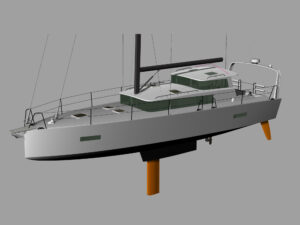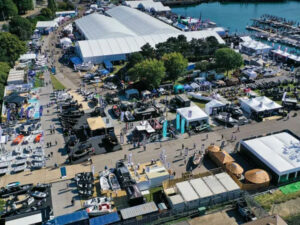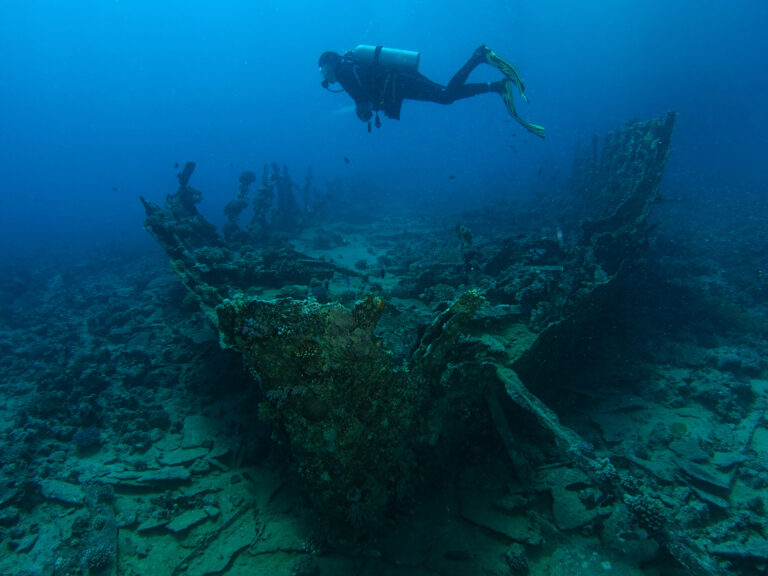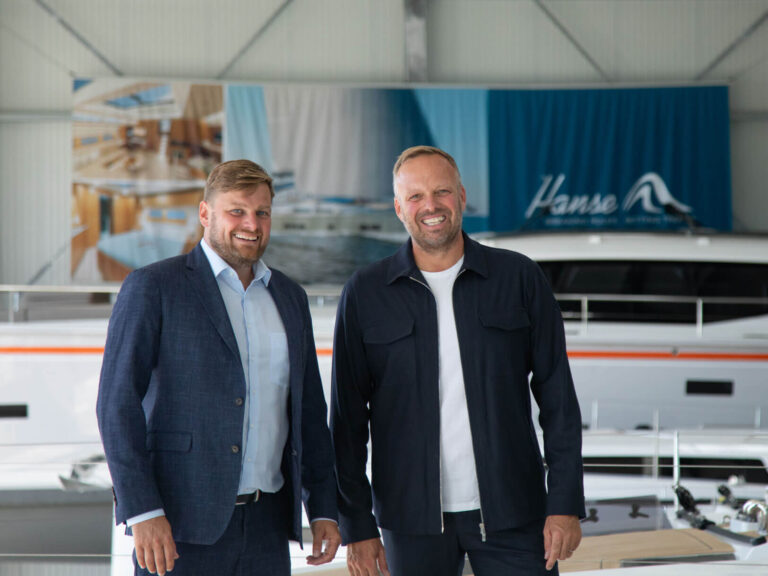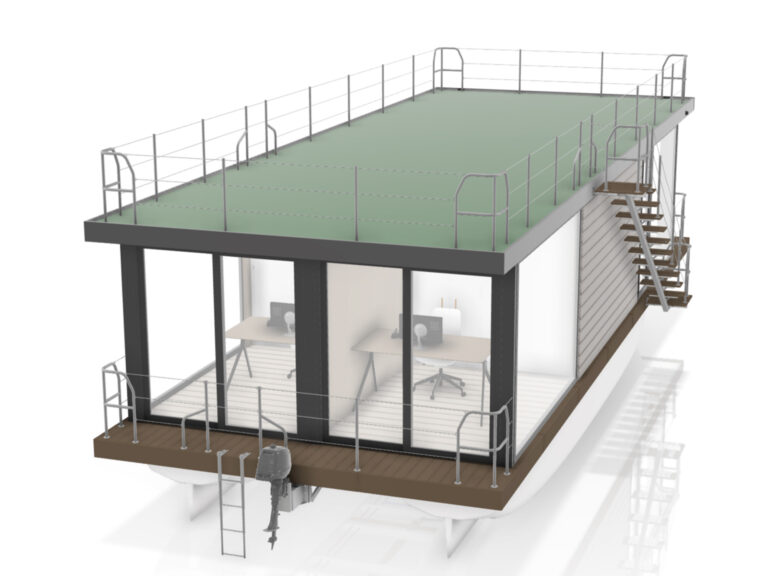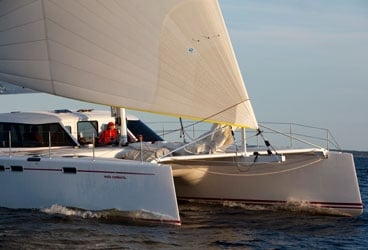
mala 368
For the cruising sailor looking for generous living space, ample load-carrying ability, and a respectable day’s run, there are numerous production builders that offer catamarans addressing these attributes in combinations various enough to satisfy many a target customer.For the cruising sailor looking for generous living space, ample load-carrying ability, and a respectable day’s run, there are numerous production builders that offer catamarans addressing these attributes in combinations various enough to satisfy many a target customer. In general, the smaller the builder, the more likely it is to edge toward performance, but even these companies can’t match the desires of the gung-ho cat sailor who’s seeking a boat that lives up to the promise that multihulls raced in on back in their heyday. Where do these enthusiasts turn to find that high-performance cruising catamaran?
Any cat designer will tell you that weight is the biggest drag on a boat’s speed, hull and rig design notwithstanding. And to solve the weight conundrum, a builder has two choices: Take a step toward exotic materials and away from creature comforts, or embrace the entire package in a big budget.
For the committed fast-cat lover, one option is to go custom. Another is to take the rather less risky route of choosing a builder, such as Gunboat, that has tooling and builds to order. Either way, the process of settling on design features and following the progress of construction, with all the daily decisions entailed thereby, is a sure test of that commitment.
When a buyer goes custom, two major decisions lie in store. The first is to select a designer who can translate desires into drawings (and then transform those drawings into plans from which a builder can work). Because of the idiosyncrasies of these vessels, it pays to use a designer or company that specializes. The market for multihulls has been sufficiently strong in the past two decades or so that the field is well served with talented designers and engineers.
Once the design is settled, the next task is to find a yard to build it. Chris White, who’s achieved considerable fame through his Atlantic series of catamaran designs, advises his clients to be cautious when taking this step.
What makes the world of one-off boatbuilding so dynamic and fascinating is that it’s full of individuals who can, literally, make anything. They’ve built their businesses on the twin pillars of dedication and ingenuity. Unfortunately, lacking the third buttress of financial stability, this kind of enterprise can find itself one stage payment away from collapse, and a dispute over a change-order charge can imperil both the project and the business, not to mention the relationship between builder and client.
For this reason, White advises his clients against choosing a builder on the basis of a fixed-price bid, especially if that bid seems disproportionately lower than other bids for the same project. Boats are complicated, multihulls even more so than monohulls when it comes to structural intricacies. Every custom design has never-built-before features, most of which turn out to be labor intensive and often trigger unforeseen complications down the line. Too often, the fixed bid has to be renegotiated, and the budget is suddenly swallowed by ballooning costs.
John Lombardi builds, or rather, sculpts multihulls on a three-acre waterfront plot in You’ll Never Find It, Virginia (see “John Lombardi: Artist and Artisan,” page 54), and he won’t build a boat on a fixed price. “Time and materials,” he says. “Time and materials.” He’s been around these boats long enough to know that their designs evolve, even as they’re under construction. Rather than spend his time writing change orders for a process that’s more akin to maturation, he prefers to spend it actually building the boat. He uses contract workers, partly to keep his overhead down and partly because, as well as being highly skilled, they’re individualistic and as flexible as he is. Mike Secrest is an example. He hired Lombardi to build a Farrier 32RX trimaran and then, because he’s retired (from farming) and wanted something to do, he signed on to help build his own boat. A year later, he was still there, working on two trimarans while keeping his moored in front of the yard.
Lombardi caused a stir in the sailboat industry when the first Chris White Atlantic 42 he built won Cruising World’s 1998 Boat of the Year award for Best Cruising Multihull. He’s since built several, and the tooling awaits another customer.
White has carved himself quite a niche with his designs, which buck the conventions seen in most production-built catamarans. The most obvious feature in all of them is the cockpit that’s located forward of the deckhouse. It’s at the base of the mast, all the sail controls lead right to it, and it has a commanding view of all sectors around the boat except that covered by the stern light. Any boat in that sector is overtaking or, more likely in the mind of White and his fans, has been overtaken. From this location, the cockpit also gives a clear view aloft. Being able to see the sails is key to trimming them properly and, on a cat that’s pushing the edge of performance, keeping the boat parallel to the water.
Interestingly, Morrelli & Melvin took the same approach in its designs for the very fast Gunboat catamarans.
Besides aiming for a clientele that’s more interested in the sailing than in cocktail hour, White steers his customers toward a handful of builders that have both the necessary expertise and a stable business footing. At the time of writing, White had Atlantic 57s in build at Alwoplast, in Valdivia, Chile, and at Aquidneck Custom Composites, in Bristol, Rhode Island. He asserts that because these builders sell directly to a customer, with no marketing department or budget for glossy advertising, they’re cost-competitive with higher-end production companies.
Just as monohull sailors and multihull sailors move in their own circles of inclination, so do the builders of these boats. Most custom multihull builders are, like Lombardi, a little out of the mainstream.
Not far from Lombardi’s yard on Mobjack Bay, another specialist builder has been quietly launching multihulls in Urbanna, a sleepy Colonial-era tobacco port tucked off Virginia’s Rappahannock River. Catman Cats has built designs from Wormwood, White, Kurt Hughes, and others. In the spring of last year, the Morrelli & Melvin-designed Shooting Star was back in the yard for some interior finish work and painting. Originally, the owners had planned on doing much of this themselves, but sanding and painting the interiors of two 51-foot hulls proved a poorer prospect than doing what the boat was designed to do, which is sailing at breakneck speed. When prompted, Felix Herrin, a.k.a. the Catman, pointed out a few stress cracks of the kind designer Peter Wormwood had mentioned when he declared that a multihull without such cracks was probably too heavily built. In this case, they appeared in areas where non-structural components were lightly tabbed to the hulls and deck. Under construction in the sheds were a large power cat and a cold-molded-wood, constant-camber sailing cat designed by another legendary figure in the field, John Marples.
Marples is perhaps best known for his Searunner series of catamaran designs, and one of his disciples is Doug Jaynes, who recently brought 30 years of multihull building experience to a new facility in Reedville, Virginia. Jayne’s Marine specializes in building inspected passenger vessels-many of them Searunners-for day chartering from resorts, but the yard has a hydraulic trailer, a ramp from which it can haul and launch, and plenty of space to store and work on multihulls of all stripes.
Catman, Lombardi, and other niche builders around the world get by even in the current financial climate because many long-established traditional builders, it would appear, have preferred to stick to their comfort zone, building monohulls. That may be changing.
In April last year, Lyman-Morse Boatbuilding, in Thomaston, Maine, launched Mala Conducta , a 62-foot catamaran designed by Morrelli & Melvin; it was a first for that very “establishment” yard. As well as there being two of everything, the company’s Scott Layton commented, the whole process involving pre-preg carbon-fiber and Kevlar laminates was a new venture for the yard. This, too, was a time-and-materials contract because of the high probability that changes would trigger changes.
On the U.S. West Coast, Schooner Creek Boat Works in Portland, Oregon, launched a 52-foot Morrelli & Melvin design in 2006. A 65-foot M&M design is under construction, and a second on order, at Westerly Marine, in Santa Ana, California. Both of these yards have over 30 years of experience building racing and cruising sailboats of considerable size with leading-edge technology, so they’re well prepared to branch out into multihulls.
A one-off or even a semicustom build is almost as much of a full-time job for the owner as it is for the builder. For a prospective owner who’s not ready for that degree of engagement, a production builder may have an answer. Many builders of production catamarans offer various degrees of customization on platforms that are already established and, in many cases, designed with one eye on the charter business. The variable features are usually limited to interior and deck layouts, not performance. Tuning up a cat means trimming weight or adding sail area, or both, and this isn’t easily accomplished without also re-engineering the structure, which leads to re-engineering the price.
After processing all the logical arguments for not building a one-off or custom boat of any number of hulls, there remains the one quality such a boat offers that’s immune to reason: individuality. Everyone involved-designer, builder, sailmaker, and owner-has that much more invested. Wherever the boat goes, it takes with it a part of each individual involved in its creation. There isn’t another one like it in the world. It’s unique-a novelty.
Jeremy McGeary is a CW contributing editor, and though he’d prefer a craft with classic lines and baggywrinkle in the rigging, he does appreciate a multihull with a good turn of speed.


